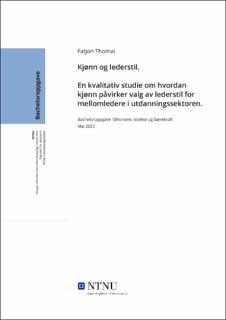| dc.contributor.advisor | Syversen, Anne Grethe | |
| dc.contributor.author | Thomai, Fatjon | |
| dc.date.accessioned | 2022-07-09T17:20:37Z | |
| dc.date.available | 2022-07-09T17:20:37Z | |
| dc.date.issued | 2022 | |
| dc.identifier | no.ntnu:inspera:106261393:112699236 | |
| dc.identifier.uri | https://hdl.handle.net/11250/3004362 | |
| dc.description.abstract | Oppgaven er gjennomført i samarbeid med en videregående skole som er en del av utdanningssektoren. Som en sentral sektor i samfunnet er det viktig å sette søkelys på lederskap og lederstil her. Målet med undersøkelsen er å avdekke om kjønn kan være en variabel i anvendelse og valg av lederstil. Det fører til problemstillingen: Er det forskjeller mellom kvinnelig og mannlig lederstil i utdanningssektoren? Problemstillingen har tre delproblemstillinger for å gi et fullverdig og helhetlig svar. Problemstillingen og dens tre delproblemstillinger styrer den tematiske strukturen gjennom oppgaven. Først blir teorien presentert med fokus på kjønnsforskjeller og likheter i lederskap. Deretter funn og drøfting, inndelt etter kategoriene lederegenskaper, lederatferd og lederstiler.
Det er blitt brukt kvalitativ metode i undersøkelsen. Innsamling av data er gjennomført gjennom seks dybdeintervjuer av mellomledere ved informantskolen, tre menn og tre kvinner. Resultatene presenteres i samme rekkefølge som teorien. Med utgangspunkt i at datainnsamlingen var stor, er det noe data som ikke svarer direkte på problemstillingen, og blir presentert i form av oppsummeringer. Data som er diskusjonsverdig presenteres og støttes med sitater fra lederne.
I diskusjonskapitlet blir resultatene fra datainnsamlingen drøftet sammen med utvalgt teori. Drøftingen blir presentert i samme tematisk rekkefølge som delproblemstillingene. Drøftingen av delproblemstillingene bidro til å gi et helhetlig svar for den overordnede problemstillingen.
Konklusjonen i undersøkelsen er at det finnes forskjeller mellom kvinnelig og mannlig lederstil blant lederne som deltar i undersøkelsen. «Familiær kommunikasjon» er begrepet som viste forskjellen mellom kjønn i lederegenskaper. Identifisering av begrepet skaper en skillelinje i lederatferd, da det forekommer forskjeller i kommunikasjon, virkelighetsforståelse og konflikthåndtering. Skillelinjen skaper to ulike retninger. De to separate linjene fortsetter videre i harmoni med forskjellig lederstiler. Undersøkelsen viser at kvinnelig ledere tenderer mer i en demokratisk-relasjonsorientert lederstil med tilnærming til transaksjonsledelse, mens mannlig ledere tenderer en autoritær-oppgaveorientert lederstil med kontinuitet i transaksjonsledelse. | |
| dc.description.abstract | This study has been carried out in collaboration with an upper secondary school, which is part of the education sector. It is important to have a closer look at leadership and the style of leadership in this area, as it is a central sector in society. The aim of the study is to uncover whether gender can be a variable in the application and choice of leadership style. This leads to the main thesis question: Are there differences between female and male styles of leadership in the education system? The main thesis question has three sub-questions to give an adequate and comprehensive answer to the main thesis question. The main thesis question and its three sub-questions govern the thematic structure throughout the thesis. First, the theory is presented with a focus on gender differences and similarities in leadership. The results and discussion are following, divided by the categories of leadership qualities, leadership behaviour and leadership styles.
Qualitative method has been used in the survey. Data collection was obtained through six in-depth interviews with middle leaders from the participating school, three men and three women.
The results are presented in the same order as the theory. Since the data collection was large, there is some data that does not directly answer the main thesis question and is presented in the form of summaries. Data worthy of discussion are presented and supported by citations from the leaders.
In the discussion, the results from the data collection are discussed and argued together with selected theory. The discussion is presented in the same thematic order as the sub-questions, and it helped providing a comprehensive answer to the main thesis question.
The conclusion of the survey shows that there are differences between female and male leadership styles among the leaders participating in the survey. “Family communication” is the term that showed the difference in leadership qualities between genders. The identification of the term creates a dividing line in leadership behaviour, as there are differences in communication, understanding of reality and conflict management. The dividing line creates two different directions. The two separate lines continue in harmony with different leadership styles. The study shows that female leaders tend more to a democratic relationship-oriented style of leadership with an approach to a style of transformation leadership. The male leaders tend more to an authoritarian task-oriented style of leadership with continuity in transactional leadership. | |
| dc.language | nob | |
| dc.publisher | NTNU | |
| dc.title | Kjønn og lederstil,
En kvalitativ studie om hvordan kjønn påvirker valg av lederstil for mellomledere i utdanningssektoren. | |
| dc.type | Bachelor thesis | |
